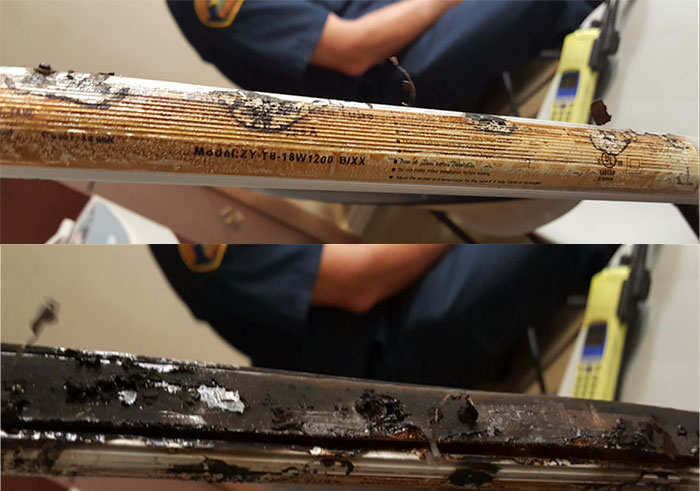James Industry Dual-Mode T-8 Replacement Tube Model No. ZY-T8-18W1200 BIXX in which the HOA fire began (cause under investigation).
 WEST CALDWELL, NJ—On July 5, 2017, UL issued a warning concerning potential hazards presented by James Industry’s Direct Replacement Dual-Mode LED Tube, Model Number ZY-T8-18W1200 BIXX. UL’s position is that this product does not comply with UL Standards for Safety, bears an unauthorized UL Mark for the United States and Canada, and poses a potential fire hazard.
WEST CALDWELL, NJ—On July 5, 2017, UL issued a warning concerning potential hazards presented by James Industry’s Direct Replacement Dual-Mode LED Tube, Model Number ZY-T8-18W1200 BIXX. UL’s position is that this product does not comply with UL Standards for Safety, bears an unauthorized UL Mark for the United States and Canada, and poses a potential fire hazard.
On July 11, 2017, James Industry, the company whose product was the subject of the UL report, issued a statement that the UL warning was limited to the company’s initial 1,000 pieces, which were “production samples” produced in 2014, and that all 1,000 pieces have since been “returned to the factory in China.”
Lighting manufacturer Maxlite believes there are several important points that are absent from the James Industry statement that should be clarified in the interest of public safety. Below, find their letter addressing these points.
——————–
First, the James Industry product in question is a “Dual-Mode” LED retrofit tube. As such, it combines a Type “A” (ballast connected) mode and a Type “B” (ballast bypass) mode in a single tube, and also allows for single-sided or double-sided installation. There is currently no UL standard that specifically covers these new dual-mode tubes; thus, for example, since it can act as a Type B tube, a dual-mode tube presents the same potential safety issues as a Type B tube but can easily be presented to UL and/or sold as a Type A tube. Yet the UL instruction and warning requirements that apply to Type B tubes (as mandated under UL1598C) are not required in the case of dual-mode tubes.
Second, the use of dual-mode LED replacement tubes is potentially dangerous, resulting in the routine mislabeling of lamps; the lack of necessary warning markings; increased risk of fire; increased risk of shock; voiding of the fixture’s UL Listing; and ineligibility for utility rebates.
The typical scenario is as follows: when a dual-mode lamp is installed, it will either be connected to an existing ballast or directly to the branch circuit. Either way, the dual-mode lamp creates a dangerous situation: (i) If the dual-mode product is connected directly to the branch circuit (i.e., a ballast-bypass installation), the person wiring the fixture will not have access to the appropriate warning labels to affix to the fixture as required under UL1598C, resulting in a non-compliant and potentially dangerous installation. Crucial safety information such as the appropriate replacement lamp type will be missing or incorrect and, in addition, the UL listing on the fixture is voided (something that the dual-mode lamp sellers do not tell their customers), and (ii) If the dual-mode product is connected to a ballast, then when the ballast eventually fails (which is not unlikely) and the dual-mode fixture is being rewired, the person removing the ballast and re-wiring the fixture will not have access to the appropriate warning labels to affix to the fixture as required under UL1598C, resulting, as described in the preceding paragraph, in a non-compliant installation.
Of further concern in the case of nearly all dual-mode products is that a potential shock hazard is presented if one end of the dual mode tube is installed into a live lamp holder while the pins on the other end are exposed to contact by the installer. The danger is magnified when taking into account the reaction hazard present if the installer is standing on a ladder or scaffold at the time of installation. (It should be noted that certain manufacturers claim that their dual-mode tube design does not present this shock hazard.)
Disturbingly, there have been reports of fires involving the James Industry Direct Replacement Dual-Mode LED Tubes, including the very tube that was identified in the UL report (Model Number ZY-T8-18W1200 BIXX).
On October 8, 2016, a fire erupted at the four-story Four Seasons Homeowners Association building, located in Beverly Hills, California. The fire and resulting smoke condition caused damage throughout the building and its cause is currently under investigation. The fire began in a James Industries’ Direct Replacement Dual-Mode LED Tube (Model Number ZY-T8-18W1200 BIXX).
Another fire occurred on December 7, 2016 in Chelsea, Massachusetts at a large cold storage facility owned by State Garden, Inc. This fire again involved a James Industry dual-mode LED retrofit T8 tube.
James Industry’s assertion that all of the products subject to UL’s warning have been pulled from the market and returned to China, and the suggestion that the currently installed inventory is safe, is suspect. In fact, NEMA and UL have begun to recognize the important safety issues facing dual-mode LED retrofit tubes. MaxLite has been informed by NEMA that a task force was formed to address this issue and publish a whitepaper. UL has also recently reviewed and accepted a proposal concerning new marking requirements to be added to UL 1993 for the labeling of dual-mode products. These new requirements would, if added to the Standard following the comment and ratification process, mandate that dual-mode tubes comply with the Type B labeling requirements and be labeled as both Type A and Type B.
One final point – the industry is aware of the significant number of LED lighting rebate programs run by utilities throughout the United States. In the case of LED tubes, these rebate programs often limit rebate eligibility to either Type A or Type B tubes. However, a dual-mode tube can be “passed off” as either a Type A or a Type B tube, allowing for the circumvention of the restrictions imposed by the utilities. This has happened numerous times in the field over the past year or so. This is likely to become a more significant issue as the utilities become increasingly aware of this situation.
Links
UL Public Notice: http://www.ul.com/newsroom/publicnotices/ul-warns-of-potentially-hazardous-led-tube-lamps/
James Industry Statement: http://jamesindustry.com/content/?410.html
Tagged with MaxLite, UL






